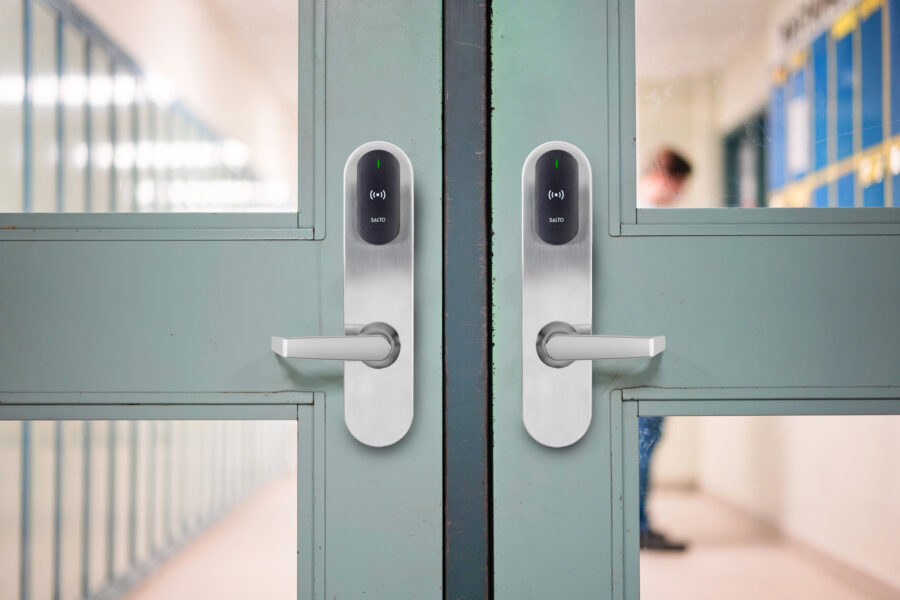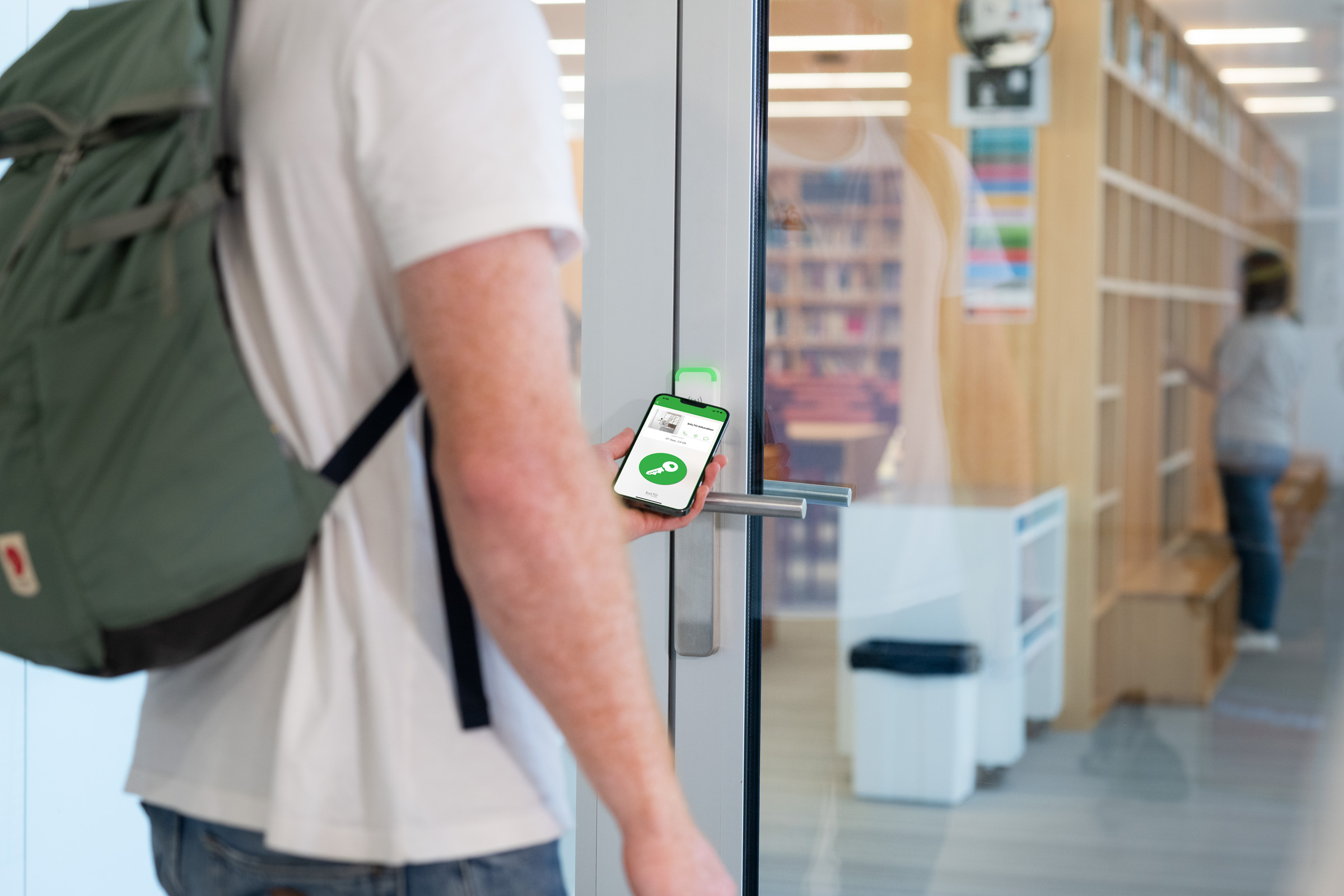Story at a glance:
- Smart locking devices can control access, offer monitoring and audit abilities, and manage safety in school buildings.
- Smartphones are increasingly used as a way to enter a property.
- Salto offers emergency readiness with lockdown functionality and AMOK function mode.
“With technological security infrastructure, there are no lunch breaks,” says Ron Shaffer, a security industry leader in education markets for Salto, maker of advanced electronic access control systems.
When it comes to schools, needs and capabilities vary widely, but Shaffer says educational institutions all must answer one question when looking to acquire a new access control system—do they want a hands-on or hands-off system?
He says what might be perceived as an extremely secure system could feel like a fortress, where everyone is locked in or out alongside security guards—in some places even armed. But that is neither a good face for a school, nor is it necessarily better or cost-effective. A better solution is one that involves smart technologies, can be highly secure yet not intrusive, offer centralized control and real-time information, and provide better overall optics—allowing a place of learning to feel like a nurturing environment that’s also safe from outside threats.
Salto offers digital alternatives to analog metal key locks. Using RFID key cards or even their smartphones, individuals can access places where they are pre-authorized. The system can also authorize first responders to enter places where and when they are needed. From a centralized control standpoint, facility administrators know who is where and at what time with the real-time capability to change that if necessary.
Impressions Matter

Photo courtesy of Salto Systems
Parents need to know students are safe while teachers and staff need safety reassurance to do their jobs. “This system tells people they are at an institution that is progressive in its use of security technology,” Shaffer says. “People love having the power of access via their smartphones.”
The technology has advanced quite a bit in the last five years, too, and the younger generation widely accepts or even expects to use mobile devices to unlock a door, Shaffer says. However, not all systems use smartphones; smart cards can be used, too.
Salto’s solutions are designed specifically to be flexible in their application.
Shaffer says a Salto can identify where a student was last, which could be useful in a missing student scenario. Schools also need a plan for emergencies and a way to strategically respond to threats, and technology must be adaptable. Salto’s solutions are designed specifically to be flexible in their application.
“First we look at the local incidence data,” Shaffer says, adding that the experts review past crimes and consider what could have been done differently to prevent shootings, for example. “We also have to understand and adapt to different local building codes. This has to be discussed on a school-by-school basis.”
Designing the Right Systems

Photo courtesy of Salto Systems
Salto’s access control systems are already in place in schools and universities all over the world—including Princeton University, Cambridge and Oxford, and major K-12 districts across the US from New York to Texas to LA.
Depending on location, building codes factor into where doors are locked and how people, sometimes in large groups, can be evacuated. It’s one of several parts of the process of designing a controlled access system that Shaffer and his team follow when working with a school district that is converting from a legacy to a new security system and protocols.
But before an educational campus begins designing a modern security program, Shaffer strongly recommends engaging stakeholders in what he calls the 5P structure:
Planning: Assess and evaluate the physical environment and potential risks
Practice and Preparedness: Training programs for staff and students
Protocols: Rules and guidelines in high-risk scenarios
Process: Identify how and where lockdowns could be implemented, and
Prevention: Restrict access to authorized users as a standard operating procedure
In light of the mass shootings of the past several years, it’s a far more sophisticated approach than depending on individual SROs or “school resource officers” who could not possibly have the building or campus-wide perspective of an advanced electronic access and monitoring system.
Rapid Emergency Response
When it comes to schools, student, faculty, and staff safety is paramount. When an emergency arises automated crisis management protocols tailored to a school’s specific requirements allow quick response to changing threat levels. A smart access control system allows you to immediately lock down specific doors, buildings, or entire campuses. An emergency lockdown can be activated for localized rooms by staff on the ground, and school- or campus-wide lockdowns can be activated remotely by administrators.
Salto’s AMOK function enables authorized users to put the electronic locks into a standalone lockdown mode using a second card reader on the inside side of the door lock. If anyone tries to enter the room when the AMOK mode is activated the outside reader shows red and the Salto lock will deny access, keeping the room and its occupants safe and secure. Once activated only authorized users with AMOK privileges—like school administrators or emergency responders—can activate it.
What are the Challenges?

Photo courtesy of Salto Systems
Pragmatic concerns include cost, ease of installation, scalability, and device protection. Can the system adapt to an evolving campus, and does the use of smartphones subject individuals to cyber risk, for example?
On cost, the wire-free Salto solutions eliminate what was once a need for control panels, wiring, power sources, and other equipment, plus the amount of electricity to run those things.
What needs to be installed is each door’s smart locking hardware; the wire-free function takes care of the rest at a much lower draw from the electrical system. Over time that upfront cost proves to be economical compared to other security systems. And to scale it up is merely a matter of adding more door locks to the system with no other costly hardware or software upgrades.
To protect users’ mobile devices, encryption technology protects data transfer while ensuring users are identified and granted appropriate access. As new technologies come online, artificial intelligence and biometrics in particular, these systems will evolve to even greater functionality.

Photo courtesy of Salto Systems

